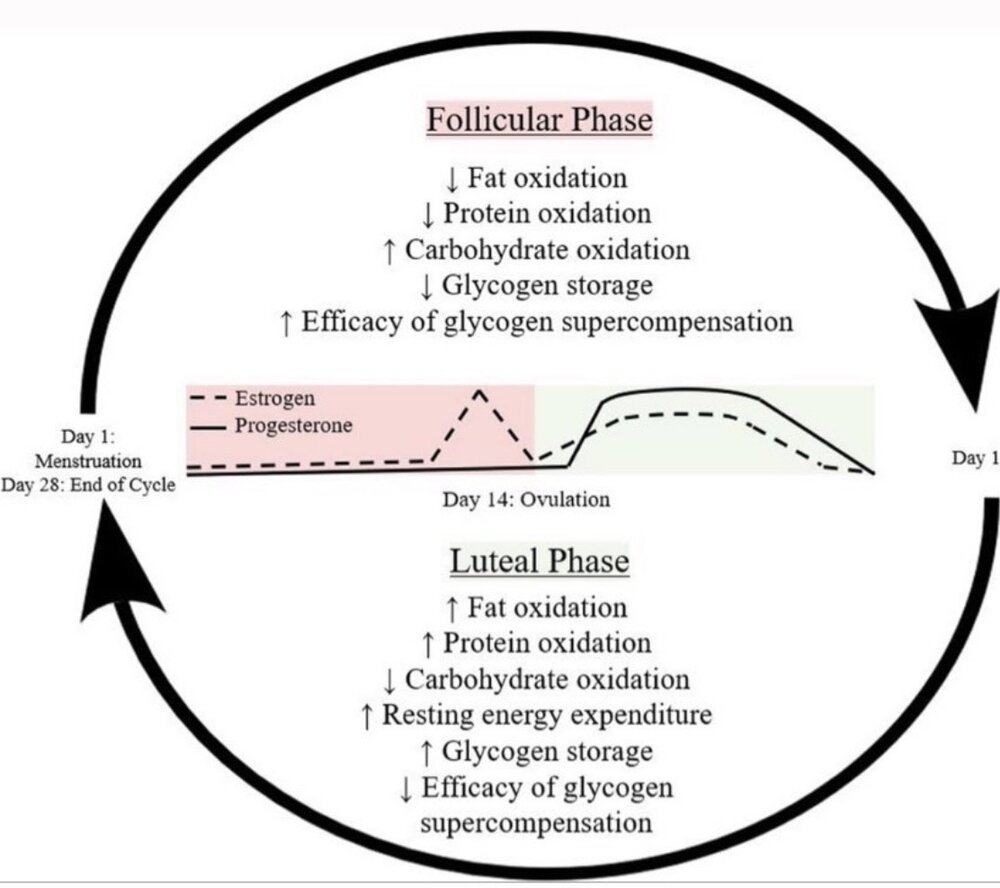EIGHT IMPORTANT NUTRITIONAL CONSIDERATIONS FOR THE FEMALE ATHLETE
Author: Brittany Kavcsak, Intern, Clearcreek Nutrition & Wellness Co.
A recent review was published on the topic of nutritional strategies and implications specific for the female athlete, Sex differences and considerations for female-specific nutritional strategies: a narrative review. The immediate buzz it made among sports dietitians, trainers, and athletes is telling of just how needed this information is in a world where female athletes are more present than ever before. Female athletes experience sex-specific hormonal changes which need to be taken into consideration when developing exercise and nutrition protocols.
The average menstrual cycle lasts an average of 28 days and consists of two main phases, the follicular phase (days 1-14) and the luteal phase (days 15-28). In the follicular phase, estrogen makes a quick rise and fall. During the following luteal phase, estrogen and progesterone both rise to their peak and fall again before the cycle comes to an end. This hormone fluctuation creates differences in our metabolic processes and nutrient needs.
So what do YOU need to know about your cycle as a female athlete?
1. Increase fat & protein intake during your luteal phase.
Throughout the luteal phase, when estrogen is at its highest, women experience a higher rate of fat and protein oxidation. What does this mean? Your body is more efficient at using these nutrients as a fuel source than during your follicular phase. You can use this knowledge to your advantage by slightly increasing your fat and protein intake during the last half of your cycle. It is recommended for female athletes to obtain at least 20% of their diet from fat sources throughout their entire cycle in order to support the demands of sex hormone regulation; with an emphasis on fat intake during the luteal phase. A new suggested baseline for protein intake for female athletes is to aim for around 1.6 grams of protein per kg of body weight. This increase is due to the higher protein oxidation in females. The amino acid leucine was shown to best stimulate muscle protein synthesis.
2. Increase carbohydrate intake during your follicular phase.
While the capacity to restore muscle glycogen stores fluctuates throughout the cycle, it is at its highest capacity during the follicular phase. The Acceptable Macronutrient Distribution Range (AMDR) suggests carbohydrates make up 45-65% of the total calories, with an additional 6-10 grams/kg per day for those looking to optimize performance.
3. Caloric needs are greater during the luteal phase.
Many of us have experienced the hunger and craving which can arise during the one to two weeks prior to our period. Diet culture may tell us to ignore these cravings, but it is actually our body’s way of letting us know it is doing more work and needs to be supported. During the luteal phase, our resting energy expenditure (REE) can increase
by 2.5-11.5%. This increase in energy expenditure, if not supported by a mild increase in calories, may impact performance and recovery for female athletes.
4. Provide support for a decreased rate of recovery during your follicular phase.
One study revealed the markers for inflammation and muscle damage to be higher during the follicular phase. Recovery rates may be impeded during this time in the cycle. It is important to recognize a possible need to plan an exercise program accordingly in order to avoid injuries and to support recovery with adequate nutrition.
5. Increase your hydration during the luteal phase.
During the luteal phase, women experience an increase in core body temperature. This increase can impact the cardiovascular system and create a strain during steady-state exercise. It may be beneficial to increase water and electrolytes to support your hydration needs throughout the last half of your cycle.
6. Adequate carb loading for endurance events held during your follicular phase.
Since carbohydrate oxidation rates are higher during the follicular phase (which means we are using those carbs most efficiently), it is even more important to increase glycogen stores prior to prolonged endurance exercise. This review recommended female athletes consider carb-loading with 8-10 grams of carbohydrates per kg of body weight, for three days prior to the event. In addition, they may further consider 1 gram/kg in the hours leading up to performance time.
7. Prime pre-workout ratio of 1:1.5, carbohydrate to protein.
An all-female study showed benefits to the specific nutrient intake timing of 1 gram carbohydrate to 1.5 grams protein taken prior to exercise. A significant increase in strength was seen compared to participants who had zero supplementation. This pre-workout regiment also showed more efficient use of fat for energy 30 minutes post-workout, compared to those who took it only after exercising.
8. Enjoy the “pump” of the follicular phase.
Our follicular phase comes with the added perk of “pumping up our muscles.” Glycogen supercompensation, or the ability of our muscles to hold more than the usual amounts of glycogen, is most efficient during the first half of our cycle. We can expect our muscles to not only appear a bit more full, but they will also have plenty of extra fuel stored for further use. Conversely, we as athletes would want to keep in mind that less of a pump in the luteal phase has less to do with our training and more to do with the metabolic process happening beneath the surface.
In recent years we have seen an increased interest in the unique ways our bodies change and adapt through our cycle, especially in how it affects the way we respond to athletic training. Understanding our hormone fluctuations, and their impact on our nutritional needs and performance outcomes is a key component to unlocking the unlimited potential for the female athlete.


